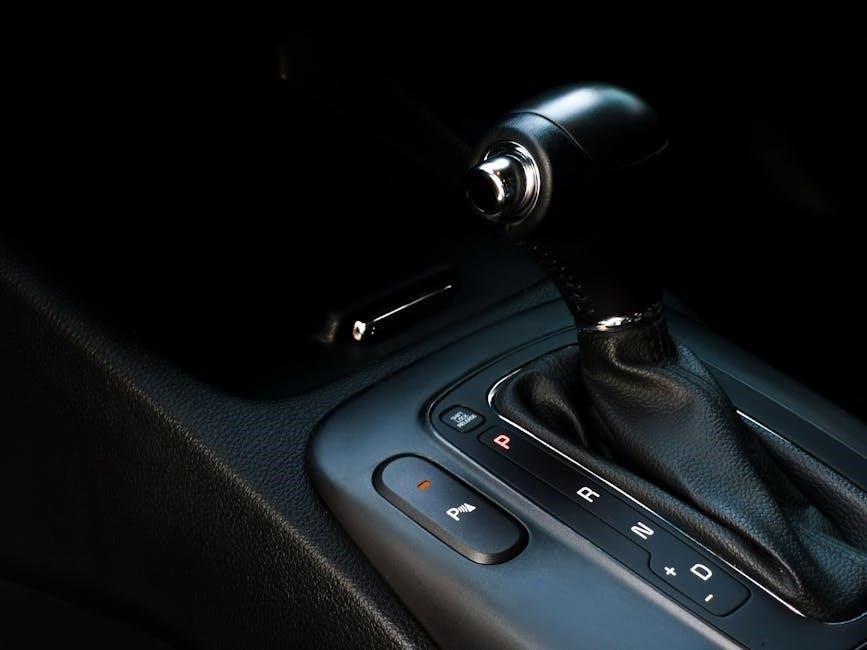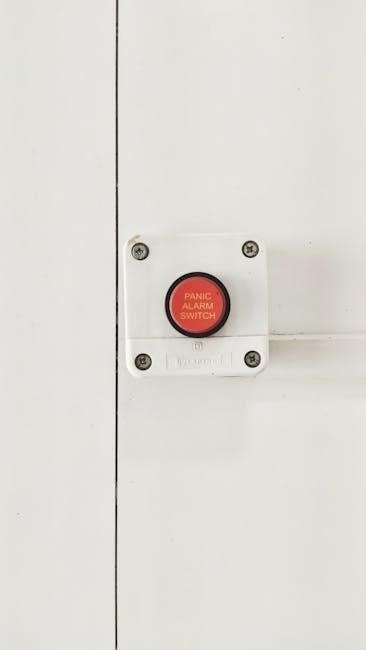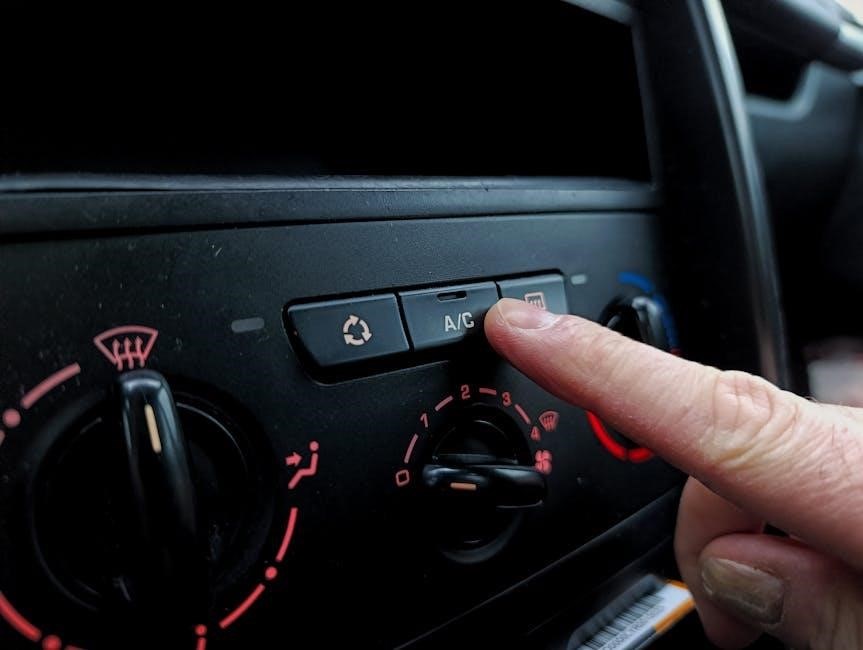This manual provides comprehensive guidance for installing, troubleshooting, and maintaining Honeywell fan limit switches, essential for optimal furnace operation and safety.
It serves as a valuable resource for homeowners and technicians, offering detailed instructions and insights into adjusting settings for efficient heating system performance.
1.1 Overview of the Honeywell Fan Limit Switch
The Honeywell Fan Limit Switch is a critical component in furnace systems, regulating fan operation based on temperature changes. It ensures the fan turns on and off at preset temperatures, preventing overheating and maintaining efficient heating. The switch features a manual/auto mode, allowing users to control the fan manually when needed. Designed for compatibility with various furnace models, it includes a high-temperature limit for safety. Proper adjustment of the fan on/off settings and differential is essential for optimal performance. Troubleshooting common issues, like the fan not turning on or running continuously, is simplified with clear diagnostic guidelines in the manual. Always refer to the manual for specific model adjustments and safety precautions to ensure reliable operation.
1.2 Importance of the Manual/Auto Fan Switch
The Manual/Auto fan switch is crucial for controlling furnace fan operation, offering flexibility and efficiency. In “Auto” mode, the fan operates based on temperature settings, optimizing heating and cooling. “Manual” mode allows continuous fan operation for consistent airflow, improving indoor air quality. Proper use of this switch ensures energy efficiency and prevents overheating. Issues like a stuck or broken switch can disrupt furnace performance, necessitating troubleshooting or replacement. Regular maintenance and correct settings are vital for reliable operation, as detailed in the manual. This feature enhances overall system functionality and user control.
1.3 Understanding the Honeywell L4064B1329 Model
The Honeywell L4064B1329 is a universal combination fan and limit controller designed for forced-air heating systems. It integrates a fan switch and high-temperature limit, ensuring safe and efficient furnace operation. This model is known for its reliability and compatibility with various furnace types, including older systems. The L4064B1329 features a manual/auto switch, allowing users to control fan operation manually or automatically based on temperature settings. It is widely used in residential heating systems and is often referenced in troubleshooting guides due to its popularity and long-standing performance. Proper installation and adjustment are crucial for optimal functionality.

Understanding the Fan Limit Switch Operation
The fan limit switch operates by monitoring furnace temperatures, controlling fan activation/deactivation, and preventing overheating. It ensures efficient heating and maintains safe operating conditions automatically or manually.
2.1 What is a Fan Limit Switch?
A fan limit switch is a critical component in heating systems, monitoring furnace temperatures to control fan operation and prevent overheating. It ensures the fan turns on or off based on temperature thresholds, providing both automatic and manual control options. This switch plays a vital role in maintaining safe and efficient furnace performance, acting as a safety mechanism to shut down the system if dangerous temperatures are reached. It is essential for proper airflow and system protection in various heating applications.
2.2 How the Fan Limit Switch Controls Furnace Operations
The fan limit switch regulates furnace operations by monitoring temperature changes and controlling the fan’s operation. It ensures the fan starts when temperatures rise above a set threshold and stops when they drop below a specified level. This switch also serves as a safety mechanism, shutting off the furnace if temperatures exceed dangerous levels. By providing both automatic and manual control options, it maintains efficient heating and prevents system damage. Proper adjustment of its settings is crucial for optimal performance and safety in heating systems.
2.3 The Role of the Manual/Auto Switch
The Manual/Auto switch on the Honeywell fan limit switch allows users to override automatic fan operation, providing flexibility in furnace control. In manual mode, the fan runs continuously until turned off, aiding in troubleshooting or air circulation. Auto mode enables the fan to operate based on temperature settings, optimizing energy efficiency and system performance. Proper switch operation is vital to prevent issues like continuous running or failure to start, ensuring safety, efficiency, and reliable furnace operation. Regular inspection and maintenance of the switch are recommended to uphold its functionality and prevent potential hazards.
Troubleshooting the Honeywell Fan Limit Switch
Identify common issues like faulty switches or wiring problems. Check for stuck switches, clean contacts, and ensure proper voltage supply. Consult the manual for diagnostic steps.
3.1 Common Issues with the Fan Limit Switch
Common issues include the switch being stuck in manual mode, continuous fan operation, or failure to activate. Faulty wiring, high-limit trips, and incorrect temperature settings are frequent problems. Cleaning the contacts, ensuring proper voltage, and verifying wiring connections often resolve these issues. Additionally, obsolete or incompatible replacement parts can cause malfunctions. If the fan won’t turn on or runs constantly, check the manual/auto switch and temperature settings. Addressing these common problems early prevents more severe furnace operational issues and ensures reliable heating system performance.
3.2 Diagnosing a Broken Manual/Auto Switch
Diagnosing a broken manual/auto switch involves checking its functionality and connections. Start by ensuring the switch is set to the correct mode. If it’s stuck, gently clean or replace it. Verify wiring connections and consult the wiring diagram for accuracy. Test the circuit for proper voltage using a multimeter. If the fan doesn’t respond, the switch may need replacement. Regular inspection and maintenance can prevent such issues. Always refer to the manual for specific troubleshooting steps tailored to your Honeywell model, ensuring safe and effective diagnosis.
3.3 Why the Fan Won’t Turn On or Runs Continuously
If the fan won’t turn on, check the manual/auto switch position and ensure it’s set correctly. Verify wiring connections and test for power. A faulty limit switch or incorrect temperature settings may prevent operation. For continuous running, inspect the temperature settings and differential adjustment. Ensure the furnace isn’t overheating, triggering safety limits. Clean or replace the switch if dirty or worn. Always consult the manual for specific troubleshooting steps to resolve these issues effectively and safely.

Installation and Wiring of the Honeywell Fan Limit Switch
Follow step-by-step guides and wiring diagrams for proper installation. Ensure compatibility with your furnace system, shut off power before starting, and refer to the manual for safety.
4.1 Step-by-Step Installation Guide
Begin by turning off the power to your furnace at the circuit breaker. Remove the old fan limit switch and disconnect the wires. Mount the new Honeywell switch securely, ensuring proper alignment. Connect the wires according to the wiring diagram in the manual. Set the fan on/off temperatures and differential settings as needed. Test the system to ensure proper operation. Always refer to the manual for specific wiring instructions and safety precautions. Turn off the furnace before starting any work and use a voltage tester to confirm the power is off. Follow all safety guidelines to avoid electrical hazards.
4.2 Wiring Diagrams for the Honeywell L4064B Series
The wiring diagrams for the Honeywell L4064B series provide detailed visual representations of the electrical connections required for proper installation. These diagrams outline the terminal connections, including the fan circuit, limit circuit, and power supply. Ensure the wiring matches the diagram to avoid malfunctions. Refer to the manual for specific instructions tailored to your furnace model. Verify the color coding of wires and their corresponding functions. If unsure, consult a licensed HVAC technician. Proper wiring ensures safe and efficient operation of the fan limit switch and overall heating system. Always follow safety guidelines when handling electrical components.
4.3 Safety Precautions During Installation
Always disconnect power to the furnace before starting installation to prevent electrical shock or injury. Use appropriate tools and follow the manufacturer’s guidelines. Ensure proper grounding of the system to avoid electrical hazards. Avoid touching internal components without proper insulation. Keep the work area clean and well-ventilated. Never bypass safety features or override factory settings. If unsure about any step, consult a licensed HVAC technician. Failure to follow safety precautions may result in system damage or personal harm. Adhere to local electrical codes and regulations for a safe and compliant installation.

Adjusting the Fan On/Off Settings
Adjusting the fan on/off settings ensures proper furnace operation. Use a screwdriver to set temperatures, referring to the manual for specific guidelines and safety recommendations.
5.1 Setting the Fan On/Off Temperatures
Setting the fan on/off temperatures ensures optimal furnace performance. Common settings range from 90°F to 120°F, balancing comfort and efficiency. Lower settings may cause frequent fan operation, while higher settings might reduce airflow. Adjust the dial carefully to avoid overheating or insufficient cooling. Always refer to the manual for specific guidelines tailored to your Honeywell model. Proper calibration ensures smooth operation and prevents system strain.
Remember to turn off power before making adjustments for safety.
5.2 Understanding the Differential Setting
The differential setting determines the temperature difference between when the fan turns on and off. A proper differential ensures the fan operates efficiently, preventing frequent starts and stops. Typically, a 10-15°F differential is recommended to maintain consistent airflow without overloading the system. Adjusting this setting incorrectly can lead to reduced efficiency or system wear. Always follow the manufacturer’s guidelines for your specific Honeywell model to ensure optimal performance and longevity of your furnace system.
This balance is crucial for maintaining comfort and energy efficiency.
5.3 Best Practices for Adjusting the Settings
When adjusting the Honeywell fan limit switch settings, always follow the manufacturer’s guidelines to ensure optimal performance. Start with factory-recommended settings and make incremental adjustments based on your system’s behavior. Test the settings thoroughly to avoid overheating or short cycling. Use a thermometer to verify temperature accuracy. Document all changes for future reference. Regular maintenance, such as cleaning the switch and inspecting wiring, ensures precise control. Allow the system to operate for several cycles after adjustments to observe results. This approach guarantees efficient furnace operation and extends the lifespan of your heating system.

Replacement and Compatibility Guide
Accurate identification of the Honeywell model is crucial for replacement. Ensure compatibility with existing systems to avoid operational issues. Always consult official guides for safe and efficient upgrades.
6.1 Replacing the Honeywell Fan Limit Switch
Replacing the Honeywell fan limit switch requires careful planning to ensure compatibility and safety. Start by identifying the exact model of your current switch, such as the L4064B or L4064R, to find the correct replacement. Refer to the Honeywell manual or manufacturer’s website for updated part numbers, as some models may have been discontinued or upgraded. Before purchasing, verify that the replacement switch matches your furnace’s voltage and wiring configuration. Once the new switch is obtained, follow the installation instructions provided in the manual to disconnect the old switch and install the new one. Ensure all wiring connections are securely made to avoid any operational issues. After installation, test the furnace to make sure the fan operates correctly, turning on and off at the set temperatures. If you encounter any difficulties, consider consulting a professional HVAC technician to ensure the job is done safely and efficiently. Remember, improper installation can lead to safety hazards or reduced system performance, so attention to detail is crucial throughout the replacement process.
6.2 Finding the Correct Replacement Model
Finding the correct replacement model for your Honeywell fan limit switch is crucial for proper functionality. Start by identifying the exact model number of your current switch, such as L4064B or L4064R, which can be found on the product label or in the manual. Check Honeywell’s official website or consult with a supplier to confirm compatibility and ensure the replacement model matches your furnace’s specifications. Some older models may have been discontinued, so verify if there is an updated or equivalent part available. Additionally, refer to the troubleshooting section of the manual to confirm that the issue lies with the switch itself and not another component. Once you’ve identified the correct replacement, proceed with the installation following the step-by-step guide provided in the manual. This ensures a seamless and safe replacement process, avoiding potential mismatches that could lead to operational issues or safety hazards.
6.3 Compatibility with Older Furnace Models
When upgrading or replacing a Honeywell fan limit switch in older furnace models, compatibility is key to ensuring proper operation. Many older furnaces, particularly those from the 1970s and 1980s, may require specific replacement models that match their original specifications. Honeywell offers updated versions of legacy models, such as the L4064B and L4064R, designed to work seamlessly with older systems. Always cross-reference the model number with Honeywell’s compatibility chart or consult with a supplier to confirm the correct replacement. Using an incompatible switch can lead to operational issues or safety hazards, so careful selection is essential. If unsure, consider reaching out to an HVAC professional for guidance.

Safety Features of the Honeywell Fan Limit Switch
The Honeywell fan limit switch includes high-temperature safety limits and emergency shutdown features to prevent overheating and ensure safe furnace operation, protecting both the system and home.
7.1 High-Temperature Safety Limits
The Honeywell fan limit switch features high-temperature safety limits to prevent overheating, ensuring the furnace operates within safe temperature ranges. These limits are programmable, allowing customization to suit specific furnace requirements. If the temperature exceeds the set threshold, the switch activates, shutting down the furnace to prevent damage or hazards. This feature is crucial for protecting the system and ensuring safe operation. Proper adjustment of these limits is essential for optimal performance and safety, as outlined in the manual. Always refer to the manufacturer’s guidelines to set these limits correctly and avoid potential risks.
7.2 Emergency Shutdown Features
The Honeywell fan limit switch includes emergency shutdown features that activate automatically if the furnace temperature exceeds safe operating levels. This prevents potential damage and ensures system integrity. The switch detects abnormal temperature spikes and triggers an immediate shutdown, halting heating operations while maintaining fan circulation to cool the system. This feature is designed to protect both the furnace and the surrounding environment from overheating risks. It works in conjunction with the high-temperature safety limits, providing an additional layer of protection for reliable and secure furnace operation. Regular maintenance and proper setup are essential to ensure this feature functions correctly during emergencies.
7.3 Ensuring Safe Operation
Ensuring safe operation of the Honeywell fan limit switch requires adherence to installation and maintenance guidelines. Regular inspection of wiring and connections prevents malfunctions. Cleaning the switch and checking temperature settings ensures accurate operation. Proper adjustment of the differential and temperature limits prevents overheating. Understanding the manual/auto switch function is crucial for manual overrides. Always follow manufacturer instructions to maintain safety and efficiency. This ensures the furnace operates within safe parameters, protecting both the system and the home from potential hazards.

Maintenance Tips for the Fan Limit Switch
Regularly clean the switch to prevent dust buildup and ensure proper operation. Inspect electrical connections and check temperature settings to maintain optimal performance and safety standards.
8.1 Cleaning and Inspection
Regular cleaning and inspection of the Honeywell fan limit switch are crucial for maintaining its functionality. Start by turning off the power to the furnace at the circuit breaker to ensure safety. Gently remove any dust or debris from the switch using a soft-bristled brush or compressed air. Inspect the electrical connections for signs of wear or corrosion and tighten any loose wires. Check the manual/auto switch for proper alignment and smooth operation. Clean the temperature-sensing elements to ensure accurate readings. Finally, test the switch by toggling between manual and auto modes to confirm it operates correctly. Regular inspections help prevent unexpected issues and ensure reliable performance.
8.2 Preventative Maintenance Schedule
A regular maintenance schedule ensures the Honeywell fan limit switch operates efficiently and safely. Perform a visual inspection every three months to check for dust buildup, loose connections, and switch alignment. Clean the switch and its components annually using a soft brush or compressed air. Test the manual/auto switch operation quarterly to ensure smooth transitions. Replace worn or corroded parts immediately to prevent malfunctions. Schedule a professional inspection every two years to verify electrical connections and temperature settings. Adhering to this schedule helps maintain optimal performance and extends the lifespan of the fan limit switch.
8.3 Signs of Wear and Tear
Identifying signs of wear and tear on your Honeywell fan limit switch is crucial for maintaining efficient furnace operation. Look for physical damage, rust, or corrosion on the switch or its components. If the manual/auto switch feels stiff or difficult to toggle, it may indicate wear. Additionally, if the fan operates erratically or fails to turn on/off as expected, it could signal worn-out internal parts. Unusual noises or inconsistent temperature settings are also red flags. Addressing these issues promptly helps prevent complete system failure and ensures safe, reliable operation of your heating system.

Honeywell Fan Limit Switch Model Differences
Honeywell offers various fan limit switch models, such as the L4064B, L4064R, L4064Y, and L4064W series, each with unique features, compatibility, and operational specifications for different furnace systems.
9.1 L4064B vs. L4064R Models
The Honeywell L4064B and L4064R models are designed for different furnace systems, with the L4064B typically used in older, non-intermittent pilot systems, while the L4064R supports newer, intermittent pilot setups. Both models share similar temperature range settings but differ in wiring configurations and compatibility with specific furnace controls. The L4064B is known for its simplicity and reliability in traditional systems, whereas the L4064R offers enhanced features for modern furnaces, including improved safety protocols and better integration with advanced heating systems. Choosing the correct model is crucial for proper furnace operation and safety.
9.2 L4064Y and L4064W Series Differences
The L4064Y and L4064W series differ primarily in their control mechanisms and compatibility. The L4064Y features a mechanical design with a focus on temperature-based fan control, making it suitable for systems requiring precise on/off settings. In contrast, the L4064W incorporates electronic controls for smoother operation and better integration with modern heating systems. The L4064W also offers additional safety features, such as enhanced high-temperature limits and faster response times, making it ideal for updated furnace models. Both series are reliable but cater to different system requirements and technological preferences.
9.3 Legacy Models and Their Replacements
Legacy Honeywell fan limit switch models, such as the L4064B and L4064W, have been phased out and replaced with updated versions like the L4064B2236 and L4064B2266. These newer models offer enhanced features, including improved temperature sensitivity and expanded compatibility with modern furnace systems. Replacing legacy models ensures better performance and safety, as older units may lack current safety certifications and energy-efficient designs. Always consult Honeywell’s compatibility guide to find the correct replacement for outdated switches, ensuring seamless integration and optimal furnace operation.

Electrical Considerations
This section covers the electrical requirements for the Honeywell fan limit switch, including voltage specifications, wiring guidelines, and safety precautions to ensure proper installation and operation.
10.1 Voltage Requirements
The Honeywell fan limit switch typically operates on a 24V AC power supply, ensuring compatibility with most HVAC systems. It is crucial to verify the voltage rating specified in the manual to avoid damage or malfunction; Incorrect voltage can lead to improper switching, safety hazards, or component failure. Always ensure the power supply matches the switch’s voltage requirements before installation. This section emphasizes the importance of adhering to electrical specifications to maintain safe and efficient operation of the fan limit switch in your heating system.
10.2 Wiring Connections and Compatibility
Proper wiring is critical for the Honeywell fan limit switch to function correctly. Ensure all connections match the wiring diagram in the manual, as incorrect wiring can lead to operational issues. The switch is designed to be compatible with most standard HVAC systems, but verifying compatibility with your specific furnace or heating system is essential. Always use the correct gauge and type of wire to avoid overheating or signal loss. If unsure, consult a licensed technician to ensure safe and proper installation. This step is crucial for maintaining system efficiency and safety.
10.4 Handling Electrical Components Safely
When working with the Honeywell fan limit switch, always prioritize electrical safety. Ensure the power to the furnace is turned off at the circuit breaker before handling any components. Use appropriate tools and avoid touching live wires or terminals. Never bypass safety features or attempt shortcuts, as this could lead to electrical hazards or system damage. If unsure about any procedure, consult a licensed electrician or HVAC technician. Proper handling ensures safe installation, maintenance, and operation of the fan limit switch, protecting both the system and the user from potential risks.

Frequently Asked Questions
- Can I repair the manual/auto switch? Yes, but often replacement is more reliable.
- How do I set the fan on/off settings? Adjust the temperature limits as per the manual.
- Where can I find replacement parts? Check Honeywell’s official website or authorized distributors.
11.1 Can I Repair the Manual/Auto Switch?
Repairing the manual/auto switch is possible but often not recommended due to potential reliability issues. If the switch is stuck or malfunctioning, replacement is typically the most reliable solution. For older models like the Honeywell L4064B1329, finding compatible parts can be challenging, and modern replacements may offer better performance. Always refer to Honeywell’s official resources or authorized distributors for guidance on repairs or replacements to ensure compatibility and safety.
11.2 How Do I Set the Fan On/Off Settings?
To set the fan on/off settings, locate the temperature adjustment levers on your Honeywell fan limit switch. These levers control when the fan turns on and off based on temperature. Typically, set the “fan on” temperature lower (e.g., 90°F) and the “fan off” temperature higher (e.g., 120°F). The differential setting determines the temperature range between cycles. Adjust these settings carefully to balance comfort and energy efficiency. For older models like the L4064B, refer to the manual or manufacturer guidelines for precise instructions to ensure proper operation of your heating system.
11.3 Where Can I Find the Replacement Part?
To find a replacement part for your Honeywell fan limit switch, visit Honeywell’s official website or authorized distributors. Check online retailers like Amazon or eBay for availability. If the model is obsolete, look for compatible or updated versions. Contact local HVAC suppliers or repair services for assistance. Ensure to purchase from reputable sources to avoid counterfeit products. For discontinued models, consider upgrading to a newer system. Explore HVAC forums for advice and alternative solutions to locate the correct replacement efficiently.
The Honeywell fan limit switch manual serves as an essential guide for understanding, maintaining, and troubleshooting your furnace’s fan limit switch. By following the instructions and tips outlined, you can ensure optimal performance, safety, and energy efficiency. Regular maintenance and proper adjustments will extend the lifespan of your system. If issues arise, refer to the troubleshooting sections or seek professional assistance. Remember to always prioritize safety when working with electrical components. With this manual, you’re equipped to handle common challenges and keep your heating system running smoothly for years to come.
